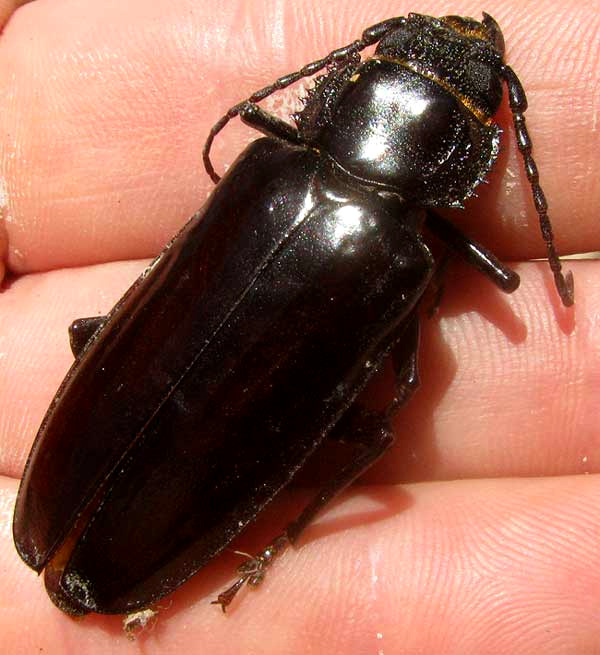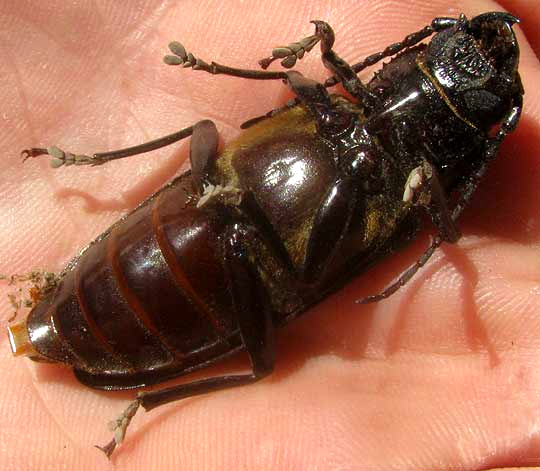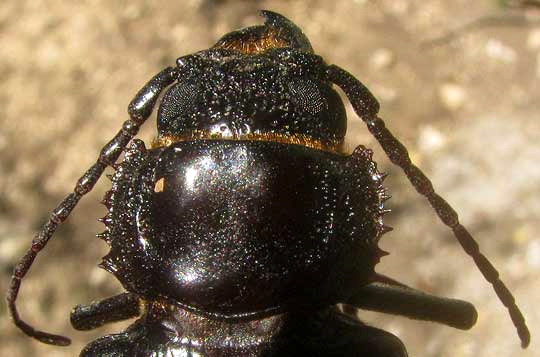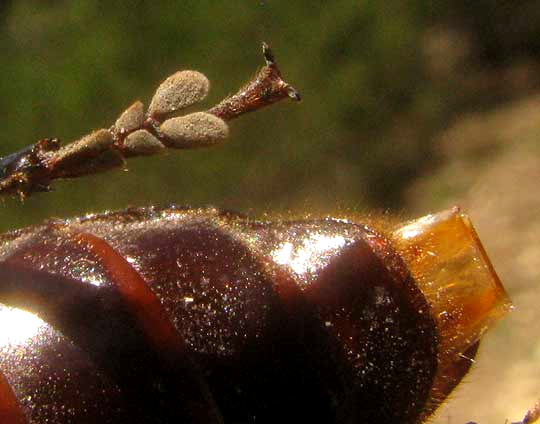Excerpts from Jim Conrad's
Naturalist Newsletter

from the June 1, 2014 Newsletter issued from the Frio Canyon Nature Education Center in the valley of the Dry Frio River in northern Uvalde County, southwestern Texas, on the southern border of the Edwards Plateau; elevation ~1750m (~5750 ft); N29.62°, W99.86°; USA
STUMP BORER
Memorial Day's first good rain of the year may also have been behind the appearance of a 1¾-inch long (44mm) beetle, dead, on my neighbor Phred's car two mornings later. That's it above.
The long antennae and general shape quickly orient us toward the Longhorned Beetle Family, the Cerambycidae, but over 35,000 species have been described for that worldwide family, so the challenge becomes figuring out which longhorned beetle we have. A view of the underside is provided below:

Volunteer identifier Bea in Ontario narrowed the possibilities to two very similar species, both having been documented in Uvalde County. They're Mallodon dasystomus, often known as the Hardwood Stump Borer, and Mallodon melanopus, usually listed as the Liveoak Stump Borer.
Since maybe 90% of our hardwood trees are liveoaks, I figured we'd have the Liveoak Stump Borer, but Bea and I both, after comparing our individual with lots of pictures on the Internet, think our dead beetle is the Hardwood Stump Borer, MALLODON DASYSTOMUS. Mainly we're looking at ornamentation on the spiny-margined part behind the head, the pronotum, and the way the pronotum's rear part flares out less in the Hardwood species than the Liveoak one. A close-up of our beetle's pronotum is shown below:

Grub larvae of Longhorned Beetles eat various plant parts, depending on the species, and the plant hosts range from healthy individuals to dead, decomposing ones. Just the name "Hardwood Stump Borer" suggests that grubs of our species spend their time tunneling through dead hardwood trees. It's known that grubs of the Liveoak one burrow through liveoak roots, forming a sort of root gall.
In the November, 2012 issue of the Journal of Insect Behavior, Matthew Paschen and others published a study of the Hardwood Stump Borer in which female beetles of the species were described as displaying a calling behavior while lowering their heads and raising their abdomens with their egg-laying ovipositors extended. Matthew Paschen also reports that while calling some females evert a membranous, cylindrical fluid-filled sac from their ovipositors, a maneuver probably involved in the production of and/or release of a male-attracting pheromone. Our dead beetle's rear end displays what might be the mentioned cylindrical sac, as shown below:

That picture also shows conspicuous pads on the beetle's hind leg, on the tarsi. These are "tarsal pads," or pulvilli. Among longhorned beetles such pads, when present, often exude adhesives, and facilitate holding onto objects. On male beetles they help the male hang onto the female.
Hardwood Stump Borers occur throughout the US southern states from Virginia and Florida west to Arizona and south through Mexico to northern South America.